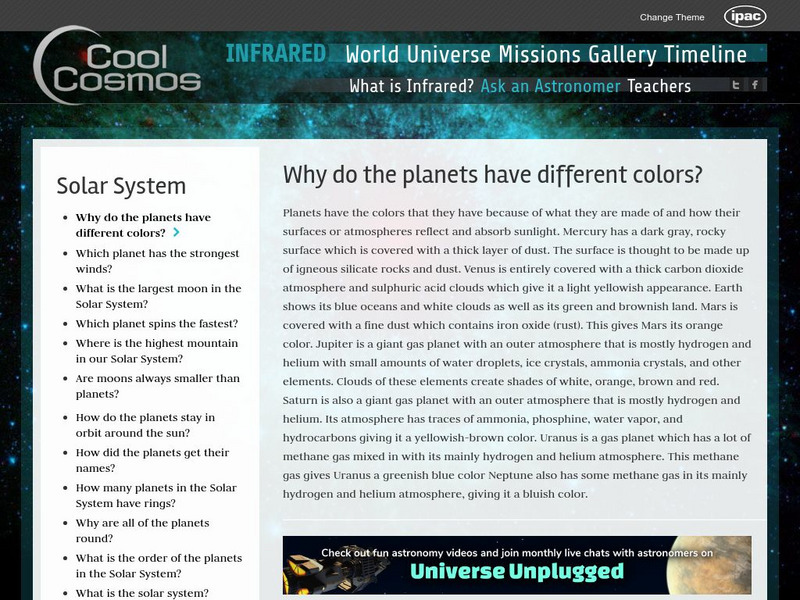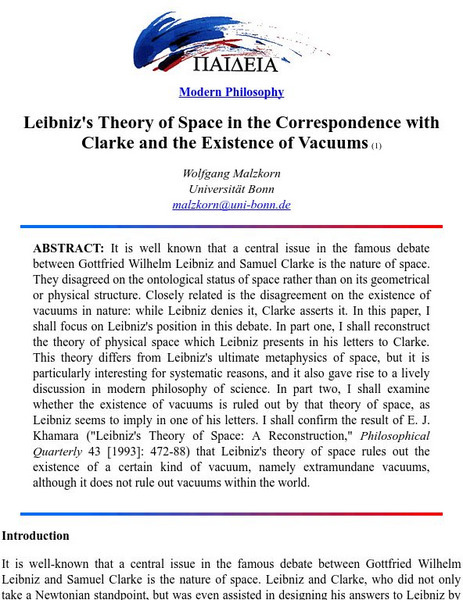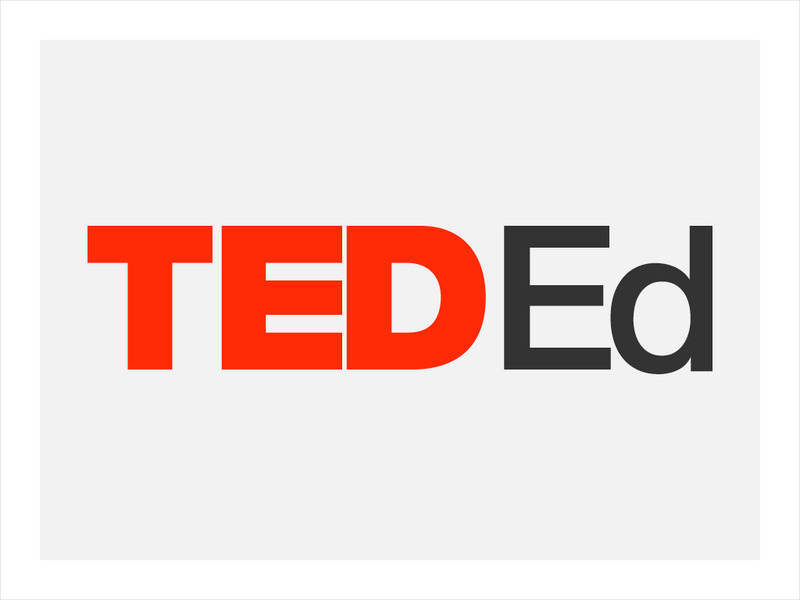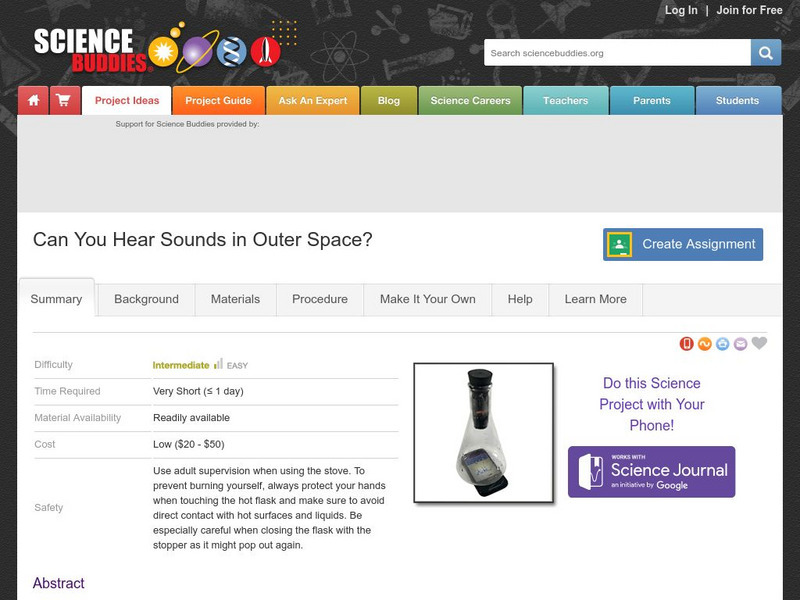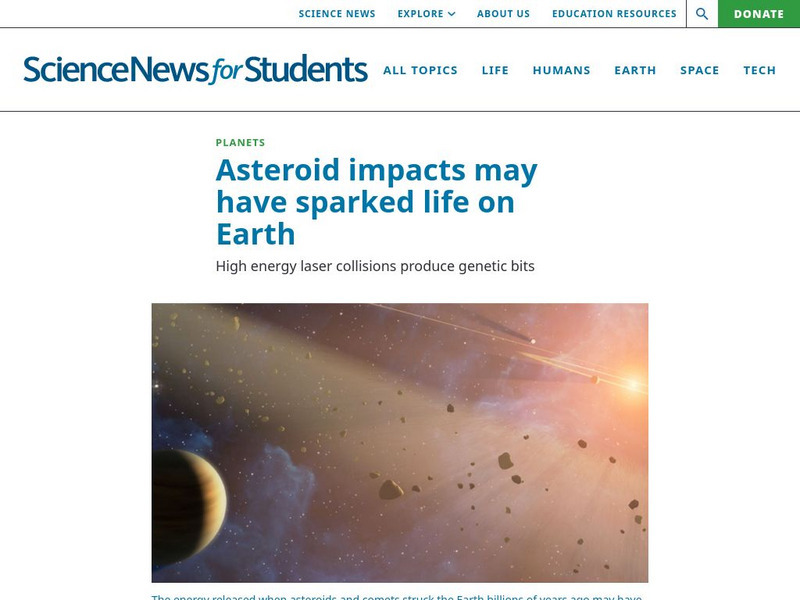Hi, what do you want to do?
Curated OER
A DISAPPEARING ACT Astronomy: Do Stars Always Shine?
Young scholars observe why stars are not visible during the day with a classroom demonstration using an index card punched with holes.
Curated OER
LIFE IN SPACE Human Body: An Un-Earthly Home
Young scholars examine an effect of zero gravity on the human body using a baby food jar, balloons and a jar with a large mouth.
Curated OER
Stargazing Astronomy: A Ceiling Full of Stars
Students make an observe a planetarium using a can with nail holes, black paper and a flashlight.
Curated OER
Listen to Grandfather - Say and Write Korean Words
Young scholars create a calligraphy piece using Korean words. They use han'gul script and write with a brush after learning the words. They pay attention to line and space as they create their work of art.
Curated OER
Space Settlement Design Project
Students design a space settlement to live in and give an oral presentation of their creation.
Curated OER
Space-Age Experiments
Students evaluate the notion of aging by reviewing some of the studies that occurred on John Glenn's space shuttle mission.
Curated OER
Celestial Photography
Students practice photographic skills and gain an awareness of photography as a scientific tool.
California Institute of Technology
Cool Cosmos: Ask an Astronomer
Resource compiles a list of most frequently asked questions about Mercury. Each question is linked to an astronomer's answer. Kids can explore many aspects of this wonderful planet.
California Institute of Technology
Cool Cosmos: Ask an Astronomer: Venus
Resource offers the answers to many frequently asked questions about Venus. Kids can click on the user-friendly question links to learn more about this amazing planet.
NASA
Nasa: Space Shuttle Glider
Assemble a basic scale model of the space shuttle as a hands-on activity. The activity features math-related concepts such as finding the scale of the paper model and the glide ratio of its flight.
California Institute of Technology
Cool Cosmos: Ask an Astronomer: Comets
Resource provides easy to understand information about comets. Click on the frequently asked question link to find out more about these mysterious celestial bodies.
California Institute of Technology
Cool Cosmos: Ask an Astronomer for Kids: Solar System
Resource presents information about the solar system through a list of most frequently asked questions. Click on each question and be transported to a wealth of knowledge about our solar system and the planets within it.
Boston University
Boston University: Leibniz's Theory of Space
This page offers a brief discussion of Gottfried Wilhelm von Leibniz's theory of space.
NASA
International Space Station: Overview
This is NASA's press release on the International Space Station
California Institute of Technology
Ipac at Cal Tech/what Are Supernovae?
Basic characteristics and definition, how astronomers study supernovae, the types of supernovae, where they occur, theories about supernovae, what supernovae tell us about the universe, and the effects of supernovae.
Georgia State University
Georgia State University: Hyper Physics: Supernovae
This site from Georgia State Department Astronomy & Physics provides information on the Supernovae. "A supernova is an explosion of a massive supergiant star." Find out much more at this site.
TED Talks
Ted: Ted Ed: If Superpowers Were Real: Flight
Is it scientifically possible to fly? In this series, creator Joy Lin tackles six superpowers and reveals just how scientifically realistic they can be to us mere mortals. [5:11]
PBS
Pbs Learning Media: Blast Off
Students are asked to describe what these astronauts should investigate on a mission in space.
Stanford University
Stanford Univ/gravity Probe B/relativity Q&a
Click "Relativity Q & A". Over 200 questions and answers dealing with relativity (special and general), answered by NASA scientist Dr. Sten Odenwald. Answers are generally one paragraph, very clear and coherent.
University of Chicago
Telescopes at Yerkes Observatory / Virtual Tour
This site describes the difference between reflective and refractive telescopes and includes a virtual tour of Yerkes Observatory which houses the largest refracting telescope in the world.
Science Buddies
Science Buddies: Outer Space, the Silent Frontier: An Experiment on Sound Waves
In outer space there is utter silence. There are no sounds of traffic jams or thunderstorms or crashing waves. No buzzing bees or babies crying. Just silence. In this experiment, you will discover why empty space is void of sound.
Seeker
Seeker: Discovery Space
Discover Space addresses broad range of topics related to space and space exploration. Subscribe to Discovery's space blogs, view a collection of videos, read interviews, and keep up with the latest space-related news and events.
ACT360 Media
Act Den: Sky Den
This journey will help you solve big questions about the universe. You will be able to see beyond human capabilities and will learn what scientists are discovering.
Society for Science and the Public
Science News for Students: Asteroid Impacts May Have Sparked Life
Article reports on a new study that claims that the energy released from asteroid collisions may have sparked life on Earth. Includes a list of key vocabulary.
















